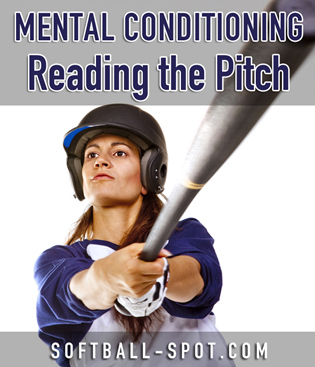| Mental Conditioning for Softball Hitting: Reading
the Pitch
Mental Conditioning for Softball Hitting Success! Most hitters should have a two-strike approach that differs from their no- or one-strike plan. The two-strike hitter wants to use the three outs. Choke up on the bat, move up to the plate, and shorten up on the swing. The hitter moves up on the plate to protect the outer half of the plate and to handle the braking ball moving away from her. She must protect that area where her greatest weakness is. For many hitters, that area is the zone down and away. The two-strike swing is a more controlled, protective, put-it-in-play type swing. Making fielders handle the ball gives the hitter an opportunity to reach base and occasionally she will get a clean hit as well. The type of pitch to hit depends upon the hitter and her plan. Most successful hitters go up looking for fastballs. They can time them and hopefully adjust to the braking ball or change-up. However, a hitter looking for an off-speed pitch, and the pitcher sneaks in a fastball, finds it extremely difficult to have the timing to hit it solidly or make contact at all. Most pitchers cannot effectively throw two or three braking balls per strikes during one at-bat. It is not a precision pitch. They are effective with braking balls when they are ahead in the count, against the impatient hitter who swings at it early in the count, or the hitter than swings when it is out of the strike zone. An experienced pitcher who knows the hitter will swing at the braking ball early in the count without success may only throw one fastball each at-bat, and most likely it will be off the plate where the hitter has to chase it. The experienced hitter either knows which counts the pitcher likes to throw the braking ball, or leaves it alone unless she has two strikes. Hitting instructors like the statement, the best way to hit the curveball is not to miss the fastball. Of course, a hitter who is looking for a fastball but gets a hanging braking ball in her productive hitting area will usually hit it solidly. An inexperienced hitter may have a problem with this thinking if they do not adjust to the speed differential and get out on their front foot, causing them to hit it weakly. Knowing the pitcher and their tendencies is a huge advantage for the hitter. If she is an excellent hitter and knows when the braking ball is coming, then she can look for it. Pitchers are creatures of habit and they throw pitches in situations and on counts that give them success. Studying a pitcher’s tendencies can lead to an understanding of what pitch she is going to throw. For example, with an 0-2 count, the pitcher throws a fastball up and in and then comes with a braking ball away. A hitter who recognizes that the pitcher has followed that pattern the whole game can be looking for a braking ball with one ball and two-strike count. Guessing and knowing what is coming are entirely different. Guessing has no background knowledge to fall back on or any solid facts to gain confidence from. Good hitting requires learning what the pitcher has, what her curveball does, when she will throw her change-up, and how she throws each one of those pitches. Knowledge is information the hitter can trust. Guessing is merely scatterbrain thinking that leads to distrust and lack of success. Softball is a game of percentages. There are ball-strike counts where a high percentage of fastballs are thrown, such as 0-0 count, 68% are fastballs; 1-0, 84%; 2-0, 93%; and 3-0, 98% fastballs. This varies slightly according to the level of play and the type of hitter at the plate, but youth and high school teams can rely heavily on these percentages. There was a report completed some years ago that compared major league batting averages to ball-strike counts. The overall batting average with no strikes was .345; with one strike, .320; and with two strikes, .235. It supports the idea that a hitter needs to be aggressive thinking every pitch is going to be a strike. This type of hitter is always looking for a good pitch to hit. She knows the strike zone and the areas in the zone that she hits best. Initially, the hitter who does not have knowledge of the pitcher or a situation should rely upon the solid approach of looking for a fastball in an area of the strike zone where she has experienced success in the past. If she stays even or ahead in the count – 0-0, 1-0, 1-1, 2-1, for example – she continues to look for the fastball. The hitter should be trying to hit the ball deep in the strike zone, especially if she gets behind in the count. Her approach when working behind also includes trying to hit the ball the opposite field. This allows her more time to react and to read the pitch, therefore, staying with the pitch better, especially the braking ball, as opposed to being too far out in front of the plate on contact. As an at-bat progresses, she relies upon her hitting routine to keep her playing one pitch at a time. Even if the hitter knows what is coming, she still must hit the pitch solidly. |



 In this article, I want to talk to you about mental conditioning for softball hitting success. We will talk about the hitters approach, reading the pitcher and her patterns, and hitting with strength and power.
In this article, I want to talk to you about mental conditioning for softball hitting success. We will talk about the hitters approach, reading the pitcher and her patterns, and hitting with strength and power.


